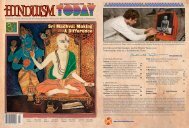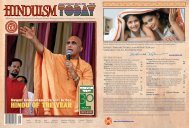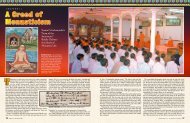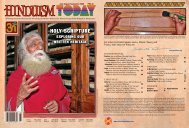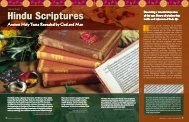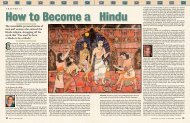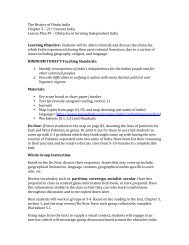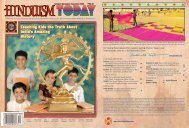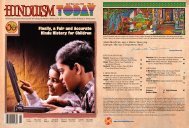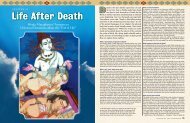Hinduism Today July 2007 - Cover, Index, Gatefold, Front Articles
Hinduism Today July 2007 - Cover, Index, Gatefold, Front Articles
Hinduism Today July 2007 - Cover, Index, Gatefold, Front Articles
Create successful ePaper yourself
Turn your PDF publications into a flip-book with our unique Google optimized e-Paper software.
Main Ideas<br />
1. Many Hindu religious<br />
practices are seen in the<br />
archeological remains of the<br />
Indus-Sarasvati civilization.<br />
2. The sacred texts of <strong>Hinduism</strong><br />
are in the Sanskrit language<br />
and were originally memorized<br />
but unwritten.<br />
3. Ancient Indian art and science<br />
were highly developed.<br />
The Big Idea<br />
<strong>Hinduism</strong> developed over<br />
thousands of years in India.<br />
Indus and Sarasvati rivers, p. 2;<br />
Vedas, p. 3; Sanskrit, p. 3<br />
HINDUISM TODAY’S<br />
TEACHING STANDARDS<br />
This column in each of the three<br />
sections presents our outline<br />
for <strong>Hinduism</strong> in 6th grade<br />
history books. It is intended to<br />
replace existing lists of required<br />
topics, such as those found in<br />
the California Standards.<br />
1. Explain the similarities between<br />
Indus-Sarasvati civilization<br />
and later Hindu culture.<br />
2. Discuss why the Aryan Invasion<br />
theory has been disputed<br />
by many scholars.<br />
3. Discuss the social and political<br />
system and advancement of<br />
science and culture.<br />
4. Explain the development of<br />
religion in India between 1000<br />
bce and 500 ce.<br />
<br />
From indus-sarasvati to modern times<br />
Indus-Sarasvati sculptures,<br />
seals and artifacts<br />
more than 5,000 years<br />
old display features of<br />
modern <strong>Hinduism</strong><br />
At left is a clay figure showing the<br />
typical Hindu greeting of “namaste”<br />
Hindu<br />
SymbolS<br />
The banyan tree is a<br />
symbol of <strong>Hinduism</strong><br />
because it gives<br />
shelter to all who<br />
approach<br />
tHe impact<br />
<strong>Today</strong><br />
The disputed<br />
Aryan Invasion<br />
theory is still<br />
taught as fact in<br />
most books on<br />
India<br />
Lord Siva in meditation is<br />
found on the Indus seals<br />
This clay figure of a woman has red sindur<br />
in the hair part—a custom followed by<br />
married Hindu women to this day<br />
<br />
Main Ideas<br />
1. Hindus believe in a one<br />
Supreme God and also many<br />
Gods and Goddesses.<br />
2. Dharma, karma and reincarnation<br />
are central Hindu<br />
beliefs. There is a special<br />
emphasis on nonviolence.<br />
3. Vedas are the primary Hindu<br />
scriptures. There are other<br />
important scriptures as well.<br />
The Big Idea<br />
Hindus believe every soul will<br />
ultimately achieve<br />
God Realization.<br />
Sanatana Dharma, p. 6<br />
Brahman, p. 6<br />
deva, p. 7<br />
puja, p. 8<br />
karma, p. 8<br />
reincarnation, p. 8<br />
<strong>Hinduism</strong> today’s<br />
teacHing standards<br />
5. Explain the basic Hindu beliefs<br />
regarding God, the Gods and<br />
Goddesses, dharma, karma<br />
and reincarnation. Describe<br />
basic Hindu practices.<br />
6. Discuss the Hindu principles<br />
of nonviolence and religious<br />
tolerance.<br />
7. Describe the Vedas and<br />
their Upanishads, Ramayana,<br />
Mahabharata (including the<br />
Bhagavad Gita) and other<br />
important Hindu scriptures.<br />
<br />
One Supreme GOd and many GOdS and GOddeSSeS<br />
Hindus believe in a one supreme and loving God. At the same<br />
time, they believe in Gods and Goddesses, great spiritual beings<br />
who help us.<br />
Ganesha is the God prayed to<br />
before beginning any task or<br />
worship. His elephant head<br />
makes Him easy to recognize.<br />
Sarasvati is the Goddess of<br />
learning and music. Below,<br />
She sits on a lotus flower playing<br />
the multi-stringed vina.<br />
Hindu<br />
SymBolS<br />
A kalasha is a husked<br />
coconut set in a brass<br />
pot with mango<br />
leaves. It is used in<br />
worship to represent<br />
the Supreme God or<br />
any of the Gods or<br />
Goddesses.<br />
academic<br />
VOcabulary<br />
subordinate<br />
lower in rank,<br />
less important<br />
pervade<br />
to be present<br />
throughout<br />
encompass<br />
to surround and<br />
hold within<br />
In the Bhagavad Gita Lord Krishna shows<br />
Arjuna His universal form as the Supreme<br />
God encompassing all the other Gods<br />
<br />
<br />
The sacred sound<br />
aum is chanted at<br />
the beginning and<br />
end of most prayers<br />
Guided ReadinG<br />
philosophy<br />
a theory or attitude that<br />
guides behavior<br />
vain<br />
excessively proud<br />
mysterious<br />
unknown<br />
consume<br />
to destroy completely,<br />
as by fire<br />
1 This verse says that the Gods<br />
were vain.<br />
What test did the Supreme God<br />
put them through?<br />
<br />
as You Read<br />
Try to sum up the meaning of each sentence<br />
in your own words.<br />
1<br />
1. Analyzing Hindus believe that the Supreme God is<br />
immanent. That means He exists everywhere in the<br />
universe, in everyone and everything. How does this<br />
belief appear in the story?<br />
The Vedas and Upanishads are written in Sanskrit,<br />
a language that is thousands of years old<br />
2<br />
Guided ReadinG<br />
adorned<br />
beautifully dressed<br />
beholding<br />
looking at something<br />
remarkable<br />
attained<br />
won; achieved<br />
2 Indra took a different<br />
approach to finding out<br />
who the spirit was.<br />
Why did he succeed when<br />
the others failed?<br />
2. Comparing What is the difference between Brahman,<br />
the Supreme God, and the other Gods introduced<br />
here—Indra, the God of fire and the God of wind?<br />
<br />
Finally, a Fair<br />
and Accurate<br />
Presentation of<br />
Hindu History<br />
for Children<br />
A 16-page sixth-grade social<br />
studies lesson from the<br />
editors of <strong>Hinduism</strong> <strong>Today</strong><br />
CHAPTER<br />
1<br />
<strong>Hinduism</strong><br />
From<br />
Ancient<br />
Times<br />
The largest civilization in the ancient<br />
world developed in the Indus Valley<br />
of India over 5,000 years ago. In the<br />
thousands of years that followed,<br />
India produced many great empires<br />
under which science, art and philosophy<br />
flourished. Out of this rich history<br />
developed the Hindu religion,<br />
today the third largest in the world.<br />
e d u c ati o n a l<br />
i n<br />
s<br />
i g h<br />
t s<br />
This young priest is conducting a<br />
fire ceremony just as was done in<br />
ancient times.<br />
from the Vedas<br />
<strong>Hinduism</strong>’s Restraints and Observances<br />
Sandilya Upanishad expounds upon the twenty yamas and niyamas<br />
andilya is the 103rd of the 108 upanishads and is<br />
attached to the Atharva Veda. It is part of a set of scriptures<br />
called the Yoga Upanishads which deal mostly with ashtanga,<br />
or eight-limbed, yoga. This excerpt from chapter one is important<br />
for its listing of the ten yamas and ten niyamas. These restraints<br />
and observances constitute the first two of the eight limbs<br />
of classical yoga—establishing a foundation of good conduct and<br />
piety so that hatha yoga and meditation can be successful.<br />
SECTION1<br />
What You Will Learn...<br />
Key Terms<br />
<strong>Hinduism</strong> <strong>Today</strong>’s 16-page Hindu history lesson<br />
is both correct and authentic, and definitely<br />
better than I have seen in any school textbook.<br />
If each Hindu were to learn and remember<br />
this narrative, the Hindu community would be<br />
better off in this increasingly pluralistic society.<br />
Shiva G. Bajpai, Ph.D Director, Center for<br />
Asian Studies, California State University<br />
This lesson corrects many of the errors in the<br />
current chapters on <strong>Hinduism</strong>, presents the<br />
religion in a sympathetic light and describes<br />
the religion in the way Hindus understand and<br />
practice it. The lesson is a commendable attempt<br />
that is acceptable to nearly all in our religion.<br />
C.K. Hiranya Gowda, M.D., Former President,<br />
Hindu Temple of Nashville, TN, USA<br />
While no document can possibly encompass<br />
fully the breadth, complexity and plurality of<br />
Hindu practice and belief, the Hindu American<br />
Foundation finds that this work compromises little<br />
in describing the universal ideals of <strong>Hinduism</strong><br />
that have emerged from its wondrous diversity.<br />
Hindu American Foundation, USA<br />
Origins of<br />
<strong>Hinduism</strong><br />
If YOU lived then...<br />
Your house is built on a wide, waterless riverbed. Your father tells you it<br />
was once the giant Sarasvati River, five kilometers across. There is not<br />
enough rain to provide for the family’s crops and cattle. Travelers tell<br />
of another great river, the Ganga, hundreds of miles away. Your father<br />
and other villagers decide they must move.<br />
How would you feel about the long journey?<br />
BUILDING BACKGROUND India’s known history begins with the Indus-<br />
Sarasvati civilization, 5,500 years ago. We know from archeology that<br />
this culture shows many features of later Hindu practice.<br />
Understanding Ancient Indian History<br />
<br />
<br />
<br />
<br />
<br />
<br />
<br />
The Religion of the Indus-Sarasvati People<br />
<br />
<br />
<br />
<br />
<br />
<br />
<br />
<br />
<br />
<br />
<br />
<br />
<br />
<br />
<br />
<br />
<br />
<br />
<br />
<br />
The Vedas<br />
<br />
<br />
<br />
<br />
<br />
<br />
<br />
<br />
<br />
<br />
<br />
<br />
<br />
<br />
<br />
<br />
<br />
<br />
<br />
<br />
<br />
<br />
<br />
<br />
<br />
<br />
<br />
<br />
<br />
<br />
The Aryan Invasion Theory<br />
<br />
<br />
<br />
<br />
<br />
<br />
<br />
<br />
<br />
section2<br />
What You Will Learn...<br />
Key Terms<br />
Hindu Beliefs<br />
and Scriptures<br />
If YOU lived then...<br />
The king has passed a new law increasing the taxes on farmers. The<br />
farmers in your village have not had a good year. The harvest is smaller<br />
than usual. The new tax may mean people will go hungry. Some in the<br />
village want to attack the tax collectors. Others want to lie about the<br />
amount of harvest. Still others say a peaceful protest will cause the<br />
king to change his mind on the tax increase.<br />
How would you respond to the tax increase? Why?<br />
Building Background From its beginnings, <strong>Hinduism</strong> has been an<br />
open-minded religion. It is a basic Hindu belief that there are many<br />
ways to approach God. <strong>Hinduism</strong> does not dictate one way as the only<br />
way. Hindus believe “Truth is one, paths are many” and that every person<br />
eventually finds spiritual salvation.<br />
Religion Permeates the Hindu’s Daily Life<br />
<br />
<br />
<br />
<br />
<br />
<br />
<br />
Belief in God and the Gods and Goddesses<br />
<br />
<br />
<br />
<br />
<br />
<br />
<br />
<br />
<br />
<br />
Note to Students, Parents and Teachers<br />
This Educational Insight is <strong>Hinduism</strong> <strong>Today</strong> magazine’s<br />
response to the controversy in California over the way<br />
<strong>Hinduism</strong> is taught in public-school history books. It is a<br />
16-page lesson on Hindu history, beliefs and practices for<br />
sixth graders written from the Hindu point of view. It is historically<br />
sound and acceptable in content and tone to the<br />
various denominations of the Hindu community.<br />
The problem with every existing textbook for this grade<br />
level is that <strong>Hinduism</strong> is presented negatively, incompletely<br />
and inaccurately. This lesson is patterned after a typical<br />
chapter on the Jewish faith in these same books. It deliberately<br />
does not follow the specific California standards for<br />
<br />
<br />
<br />
<br />
<br />
<br />
<br />
<br />
<br />
<br />
<br />
<br />
<br />
<br />
<br />
<br />
<br />
<br />
<br />
<br />
<br />
<br />
<br />
<br />
<br />
<br />
<br />
<br />
<br />
<br />
<br />
<br />
<br />
<br />
<br />
<br />
<br />
<br />
<br />
<br />
<br />
<br />
<br />
<br />
<br />
<br />
<br />
<br />
Available at www.minimela.com/booklets<br />
$1.50 each, or $99 for a box of 300<br />
<br />
Sacred Texts<br />
Word Help<br />
presenting the Hindu religion because we believe them to<br />
be deeply flawed and contrary to the State’s own general<br />
rule that teaching material must: 1) be historically accurate,<br />
2) “instill in each child a sense of pride in his or her heritage”<br />
and 3) avoid “adverse reflection” on a religion. It is our intent<br />
that this lesson will serve as a model for US textbooks,<br />
providing an authentic depiction of the eminent history<br />
and traditions of the faith while giving 10-year-old Hindu<br />
students justifiable pride in their religion.<br />
In most states teachers are allowed to supplement the<br />
textbooks with additional material. This lesson may be offered<br />
as a more accurate basis for the classroom study of<br />
the origins and development of <strong>Hinduism</strong> in ancient India.<br />
<br />
<br />
<br />
This is the most comprehensive summary of <strong>Hinduism</strong>’s<br />
multi-faceted tradition that I have seen to<br />
date. I wholeheartedly and unequivocally recommend<br />
its use in all official textbooks for students.<br />
Swami Chidanand Saraswati, Founder & Chairman,<br />
India Heritage Research Foundation, Rishikesh<br />
This presentation provides a needed counterbalance<br />
to textbooks on <strong>Hinduism</strong> which are sometimes<br />
inaccurate or fail to give a perspective that would be<br />
recognizable to most Hindus. Though designed for sixthgraders,<br />
I could imagine myself recommending these<br />
sections as review material for my college students.<br />
Jeffery D. Long, Ph.D, Chair, Department of Religious<br />
Studies, Elizabethtown College, PA, USA<br />
from the<br />
Upanishads<br />
<br />
<br />
<br />
<br />
<br />
<br />
<br />
<br />
<br />
<br />
<br />
<br />
<br />
<br />
<br />
<br />
<br />
<br />
<br />
<br />
<br />
<br />
<br />
<br />
<br />
<br />
<br />
<br />
<br />
<br />
<br />
<br />
<br />
<br />
<br />
<br />
<br />
<br />
<br />
<br />
<br />
<br />
<br />
<br />
<br />
<br />
<br />
<br />
<br />
Understanding Sacred Texts<br />
<br />
Word Help<br />
Om! O Devas, may we hear with our ears what is auspicious, may<br />
we see with our eyes what is auspicious, O ye worthy of worship!<br />
May we enjoy the term of life allotted by the Devas, praising them<br />
with our body and limbs steady! May the glorious Indra bless us!<br />
May the all-knowing Sun bless us! May Garuda, the thunderbolt for<br />
evil, bless us! May Brihaspati grant us well-being! Om! Let there be<br />
Peace in me! Let there be Peace in my environment! Let there be<br />
Peace in the forces that act on me!<br />
Sage Sandilya questioned Atharvan thus: “Please tell me about the<br />
eight angas (parts or limbs) of yoga which are the means of attaining<br />
to Atman.”<br />
Atharvan replied: “The eight angas of yoga are yama, niyama,<br />
asana, pranayama, pratyahara, dharana, dhyana and samadhi. Of<br />
these, yama (restraints) is of ten kinds; and so is niyama (observances).<br />
There are eight asanas (yoga postures). Pranayama (breath<br />
control) is of three kinds; pratyahara (sense withdrawal) is of five<br />
kinds; so also is dharana (concentration). Dhyana (contemplation) is<br />
of two kinds and samadhi (Realization) is of one kind only.<br />
“Under yama are ten: ahimsa, satya, asteya, brahmacharya, daya,<br />
arjava, kshama, dhriti, mitahara and saucha. Of these, ahimsa is<br />
the not causing of any pain to any living being at any time through<br />
the actions of one’s mind, speech or body. Satya is the speaking of<br />
the truth that conduces to the well-being of creatures, through the<br />
actions of one’s mind, speech, or body. Asteya is not coveting of<br />
another’s property through the actions of one’s mind, speech or body.<br />
Brahmacharya is the refraining from sexual intercourse in all places<br />
and in all states in mind, speech or body. Daya is kindliness towards<br />
all creatures in all places. Arjava is the preserving of equanimity<br />
of mind, speech or body in the performance (or non-performance)<br />
of the actions ordained (or forbidden) to be done. Kshama is the<br />
bearing patiently of all pleasant or unpleasant things, such as praise<br />
or physical aggression. Dhriti is the preserving of firmness of mind<br />
during the period of gain or loss of wealth or relatives. Mitahara<br />
is the taking of nutritious food, leaving one-fourth of the stomach<br />
empty. Saucha is of two kinds, external and internal. Of these, the<br />
external is the cleansing of the body by earth and water; the internal<br />
is the cleansing of the mind. This (i.e., internal cleansing) is to<br />
be attained by means of the Adhyatma-Vidya (Science of Self).<br />
“Under niyama (religious observances), are ten: tapas, santosha,<br />
astikya, dana, ishvarapujana, siddhanta-shravana, hri, mati, japa<br />
and vrata. Of these, tapas is the emancipation of the body through<br />
observance of such penances as krichchhra, chandrayana (both are<br />
types of fasts), etc., according to rules. Santosha is being satisfied<br />
with whatever comes to us of its own accord. Astikya is the belief in<br />
the merits or demerits of actions as stated in the Vedas. Dana is the<br />
faithful giving to deserving persons of lawfully earned money, grains,<br />
h induism t oday<br />
Key disciplines: Three of the ten niyamas, or religious observances:<br />
worship of God; scriptural study and japa<br />
etc. Ishvarapujana is the worshiping of Vishnu, Rudra, etc., with<br />
pure mind according to one’s ability. Siddhanta-sravana is the inquiry<br />
into the significance of Vedanta. Hri is being ashamed if one’s behavior<br />
violates the rules of the Vedas and of society. Mati is faith in<br />
the paths laid down by the Vedas. Japa is the practicing of the mantras<br />
into which one is duly initiated by his spiritual instructor and<br />
which is not against (the rules of) the Vedas. It is of two kinds—the<br />
spoken and the mental. The mental is associated with contemplation<br />
by the mind. The spoken is of two kinds—the loud and the low. The<br />
loud pronunciation gives the reward as stated in the Vedas, while<br />
the low one gives a reward thousand times that. The mental gives a<br />
reward ten millions times that. Vrata is the regular observance of (or<br />
refraining from) the actions enjoined (or prohibited) by the Vedas.<br />
K. Narayanasvami Aiyar published this translation of Sandilya<br />
Upanishad (slightly edited here) in 1914 along with the Adyar Library<br />
as part of his book, Thirty Minor Upanishads. The translations<br />
had previously appeared in the monthly journal, The Theosophist.<br />
He collaborated in the work with Sundara Sastri.<br />
The Vedas are the divinely revealed and most revered scriptures, shruti,<br />
of <strong>Hinduism</strong>, likened to the Torah (1,200 bce), Bible New Testament (100<br />
ce), Koran (630 ce) or Zend Avesta (600 bce). Four in number, Rig, Yajur,<br />
Sama and Atharva, the Vedas include over 100,000 verses. Oldest portions<br />
may date back as far as 6,000 bce.<br />
j u ly / au g u s t / s e p t e m b e r , 2 0 0 7 h i n d u i s m t o d ay 17



